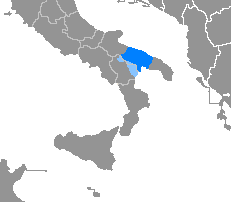Valenzano | ||
|---|---|---|
| Comune di Valenzano | ||
| ||
| Coordinates: 41°3′N16°53′E / 41.050°N 16.883°E | ||
| Country | Italy | |
| Region | ||
| Metropolitan city | Bari (BA) | |
| Frazioni | San Lorenzo | |
| Government | ||
| • Mayor | Antonio Lomoro | |
| Area | ||
| • Total | 15 km2 (6 sq mi) | |
| Elevation | 85 m (279 ft) | |
| Population (31 December 2010) [1] | ||
| • Total | 18,305 | |
| • Density | 1,200/km2 (3,200/sq mi) | |
| Demonym(s) | Valenzanesi | |
| Time zone | UTC+1 (CET) | |
| • Summer (DST) | UTC+2 (CEST) | |
| Postal code | 70010 | |
| Dialing code | 080 | |
| ISTAT code | 072048 | |
| Patron saint | St Roch, St Anthony of Padua | |
| Saint day | 15–16–17 August (St. Roch) 13 June (St. Anthony) | |
| Website | Official website | |
Valenzano (Barese: Valzàne) is a town and comune in the Metropolitan City of Bari, in Apulia, Italy. It is home to several centers of scientific research, including Tecnopolis, one of the biggest of the Southern Italy in addition to The Mediterranean Agronomic Institute of Bari (IAMB) part of the International Centre for Advanced Mediterranean Agronomic Studies (CIHEAM).

Bari dialect is a dialect of Neapolitan spoken in the Apulia and Basilicata regions of Italy. Influences range from Old French to Norman, creating one of the most distinct Italian dialects both from phonetics and lexis point of view.

The comune is a basic administrative division in Italy, roughly equivalent to a township or municipality.

The Metropolitan City of Bari is a metropolitan city in the Apulia region of Italy. Its capital is the city of Bari. It replaced the Province of Bari and includes the city of Bari and some forty other municipalities (comuni). It was first created by the reform of local authorities and then established by the Law 56/2014. It has been operative since January 1, 2015.
Contents
Sights include the All Saints' Church, a former 11th century abbey, and the late Renaissance church of St Roch. The baronial castle was reconstructed in 1870.




















